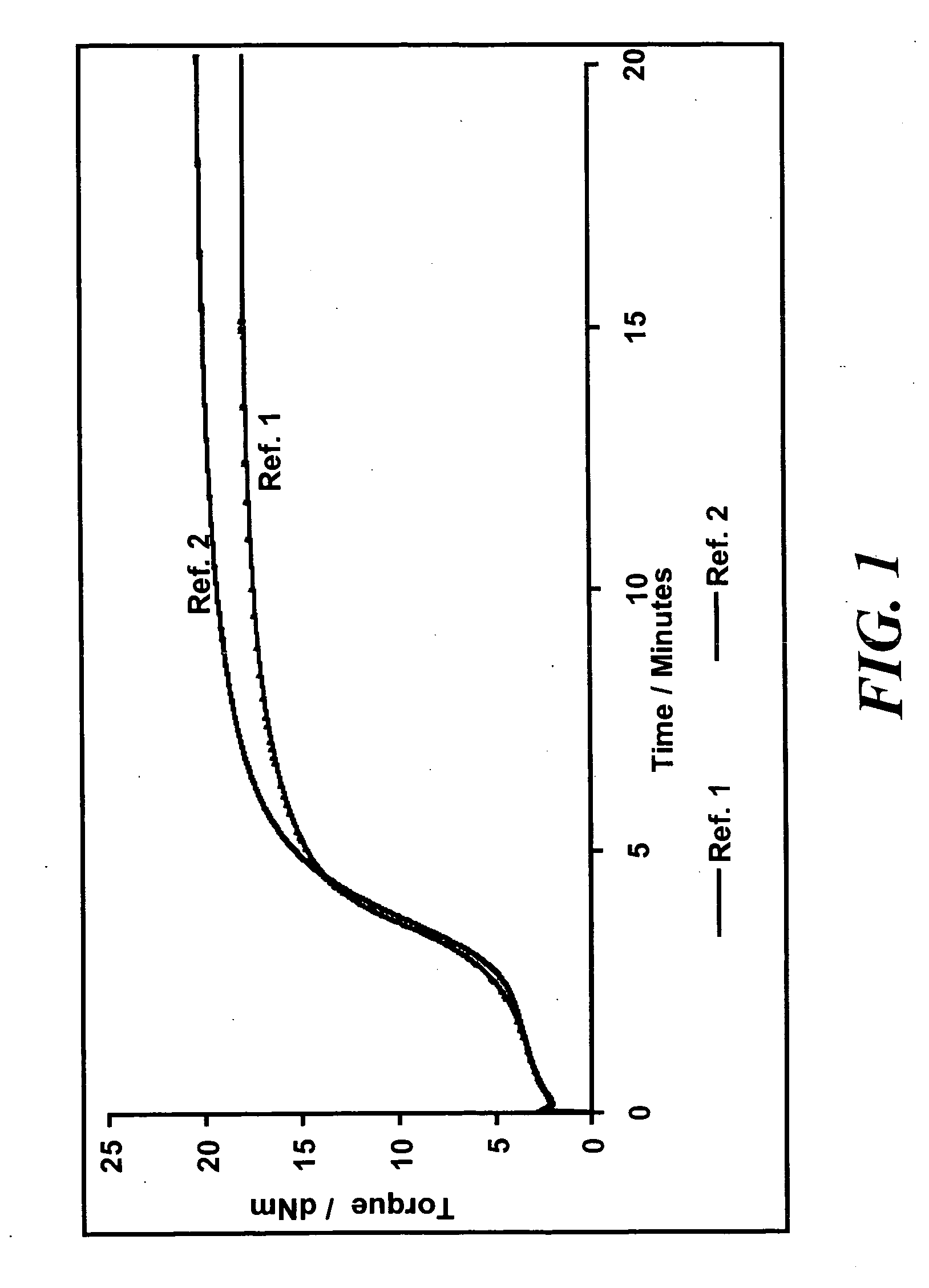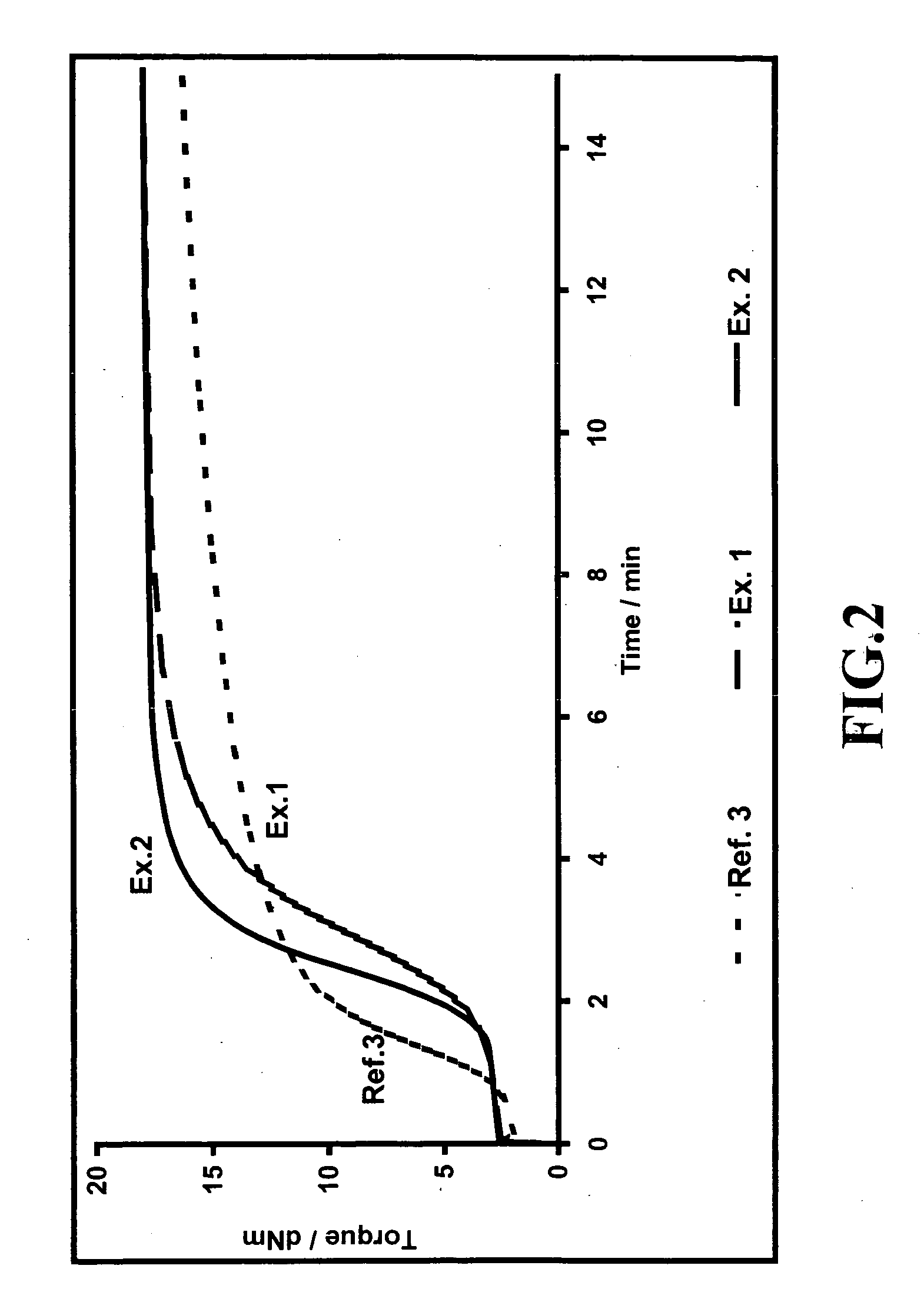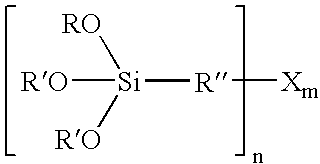Rubber mixtures
- Summary
- Abstract
- Description
- Claims
- Application Information
AI Technical Summary
Benefits of technology
Problems solved by technology
Method used
Image
Examples
examples 1-2
[0094] The formulation used for the rubber mixtures is shown in Table 1 below. In the Table, the unit phr denotes parts by weight based on 100 parts of the crude rubber used.
[0095] The silane A used for the example had the structure according to the following formula II [0096] wherein R1=a mixture of ethoxy and R4O groups in a ratio of 1:2, the R4O groups being a mixture of dodecoxy and tetradecoxy in a weight ratio of 70:30.
[0097] The silane A was prepared as follows:
[0098] In a 10-litre four-necked flask, a mixture consisting of 2.925 kg of mercaptopropyltriethoxysilane (formula II where R1=CH3CH2O) and 4.753 kg of a mixture of 70 wt. % dodecanol (CH3—(CH2)1—OH) and 30 wt. % tetradecanol (CH3—(CH2)13—OH) were heated with 1.464 ml of tetra-n-butyl orthotitanate to 110° C., and ethanol that forms was distilled off in vacuo in the course of 4 hours at a maximum of 50 mbar. 6.47 kg (98% of the theoretical yield) of a colourless, liquid mercaptopropyltrialkoxysilane of formula II w...
examples 3-8
[0116] The formulation used for the rubber mixtures described here is given in Table 5 below.
[0117] The rubber mixture was prepared in three steps in an internal mixer according to Table 2.
[0118] Testing of the rubber was carried out according to the test methods indicated in Table 3.
TABLE 5AmountAmountAmountAmountAmountAmountAmountAmount[phr][phr][phr][phr][phr][phr][phr][phr]SubstanceRef. 4Ref. 5Ex. 3Ex. 4Ex. 5Ex. 6Ex. 7Ex. 81st stepBuna VSL 5025-19696969696969696Buna CB 243030303030303030Ultrasil 7000 GR8080808080808080ZnO33333333Stearic acid22222222Naftolen ZD1010101010101010Vulkanox 40201.51.51.51.51.51.51.51.5Protector G35P11111111Si 696.4———————Silane A—5.45.45.45.45.45.45.42nd stepBatch step 13rd stepBatch step 2Vulkacit D220.250.250.250.2500Perkacit TBzTD0.20.20.250.50.7510.751Vulkacit CZ1.51.51.51.51.51.51.51.5Sulfur1.52.22.22.22.22.22.22.2
[0119] The rubber-technological data for the tested mixtures from Table 5 are shown in Table 6.
TABLE 6Feature:Unit:Ref. 4Ref. 5Ex...
examples 9-10
[0121] The formulation used for the rubber mixtures described here is shown in Table 7 below.
[0122] MPTES in this example was y-mercaptopropyltriethoxysilane, which is obtainable as VP Si263 from Degussa AG, and silane B, which can be prepared according to Example 9 of EP 0958298 B1, is 3-octanoylthio-1-propyltriethoxysilane.
[0123] The rubber mixture was prepared in three steps in an internal mixer, according to Table 2.
[0124] Testing of the crude mixtures was carried out according to the test methods indicated in Table 3.
TABLE 7AmountAmountAmountAmount[phr][phr][phr][phr]SubstanceRef. 6Ex. 9Ref. 7Ex. 101st stepBuna VSL 5025-196969696Buna CB 2430303030Ultrasil 7000 GR80808080ZnO3333Stearic acid2222Naftolen ZD10101010Vulkanox 40201.51.51.51.5Protector G35P1111MPTES2.42.4——Silane B——8.98.92nd stepBatch step 13rd stepBatch step 2Vulkacit D2.00.252.00.25Perkacit TBzTD0.20.600.20.60Vulkacit CZ1.51.51.51.5Sulfur2.22.22.22.2
[0125] Table 8 shows the results of the crude mixture tests f...
PUM
| Property | Measurement | Unit |
|---|---|---|
| Percent by mass | aaaaa | aaaaa |
| Percent by mass | aaaaa | aaaaa |
| Percent by mass | aaaaa | aaaaa |
Abstract
Description
Claims
Application Information
 Login to View More
Login to View More - R&D
- Intellectual Property
- Life Sciences
- Materials
- Tech Scout
- Unparalleled Data Quality
- Higher Quality Content
- 60% Fewer Hallucinations
Browse by: Latest US Patents, China's latest patents, Technical Efficacy Thesaurus, Application Domain, Technology Topic, Popular Technical Reports.
© 2025 PatSnap. All rights reserved.Legal|Privacy policy|Modern Slavery Act Transparency Statement|Sitemap|About US| Contact US: help@patsnap.com



